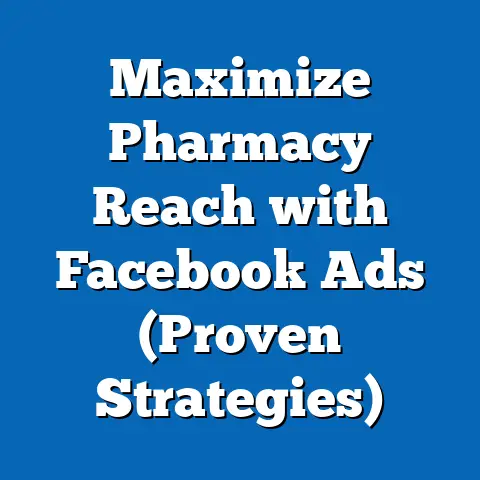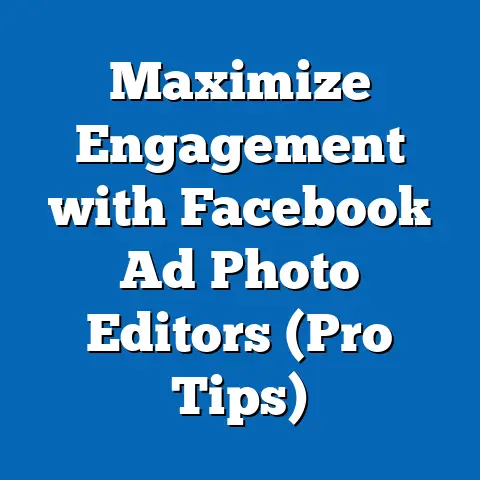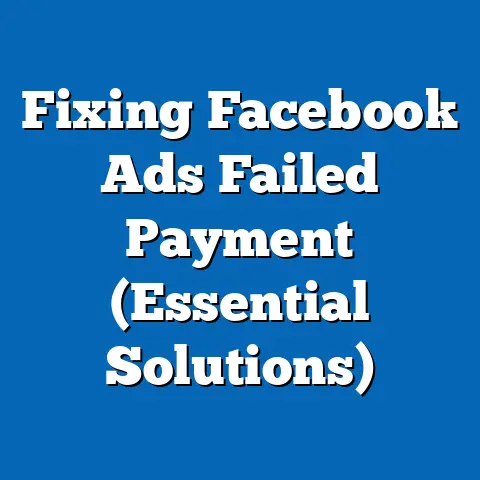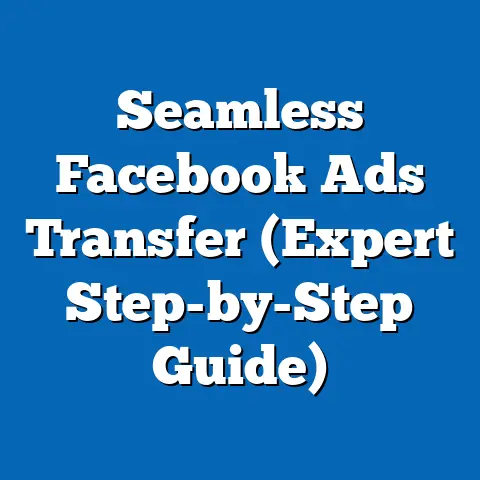Boost Ad Revenue with Google, Facebook & Amazon (Pro Tips)
It’s a common misconception I often hear: “You need a massive budget to effectively advertise on Google, Facebook, and Amazon.” I’m here to tell you that’s simply not true! While a bigger budget can certainly open doors, it’s the smart strategy and execution that truly unlock the ad revenue potential on these platforms, even for small businesses operating with limited resources. In this guide, I’ll share pro tips that will help you elevate your advertising game, regardless of your budget size.
Understanding the Platforms
Before diving into the pro tips, it’s essential to understand the nuances of each platform. Each has its strengths, weaknesses, and unique audience characteristics.
Google Ads
Google Ads is the king of search engine marketing (SEM). It allows you to place ads in front of potential customers actively searching for products or services like yours. Its significance in the digital advertising landscape is undeniable, as it captures users with high purchase intent.
-
Ad Formats: Google Ads offers a variety of ad formats:
- Search Ads: Text-based ads that appear on Google’s search results pages.
- Display Ads: Visual ads that appear on websites and apps across Google’s Display Network.
- Shopping Ads: Product-based ads that feature images, prices, and store names, primarily for e-commerce businesses.
- Video Ads: Ads that run on YouTube and other video platforms.
- App Ads: Ads designed to promote mobile app downloads and engagement.
-
Targeting and Keyword Selection: The heart of a successful Google Ads campaign lies in precise targeting and strategic keyword selection. I’ve seen campaigns skyrocket simply by refining the keyword list to include long-tail keywords that are highly specific to what customers are searching for. This minimizes wasted ad spend and maximizes relevance. For example, instead of targeting “running shoes,” try “men’s trail running shoes waterproof size 10.”
Ad Formats: Google Ads offers a variety of ad formats:
- Search Ads: Text-based ads that appear on Google’s search results pages.
- Display Ads: Visual ads that appear on websites and apps across Google’s Display Network.
- Shopping Ads: Product-based ads that feature images, prices, and store names, primarily for e-commerce businesses.
- Video Ads: Ads that run on YouTube and other video platforms.
- App Ads: Ads designed to promote mobile app downloads and engagement.
Targeting and Keyword Selection: The heart of a successful Google Ads campaign lies in precise targeting and strategic keyword selection. I’ve seen campaigns skyrocket simply by refining the keyword list to include long-tail keywords that are highly specific to what customers are searching for. This minimizes wasted ad spend and maximizes relevance. For example, instead of targeting “running shoes,” try “men’s trail running shoes waterproof size 10.”
Takeaway: Google Ads is ideal for capturing users actively searching for your products or services. Master keyword research and targeting to maximize your ROI.
Facebook Ads
Facebook Ads leverage the vast amount of user data available on the platform to reach highly specific audiences. With billions of active users, Facebook offers unparalleled reach and targeting capabilities.
- User Demographics: Facebook boasts a diverse user base spanning various age groups, interests, and demographics. According to Statista, as of early 2024, Facebook maintains its position as one of the leading social media platforms globally, with a substantial portion of its user base actively engaging with the platform daily.
-
Ad Types: Facebook offers a range of ad types to suit different marketing objectives:
- Image Ads: Simple ads featuring a single image and text.
- Video Ads: Engaging ads that use video to capture attention.
- Carousel Ads: Ads that display multiple images or videos in a scrollable format.
- Collection Ads: Ads designed for e-commerce, showcasing products in a catalog-like format.
- Lead Ads: Ads that collect user information directly within the Facebook platform.
-
Audience Segmentation and Retargeting: Facebook’s strength lies in its ability to segment audiences based on demographics, interests, behaviors, and more. I’ve found that creating custom audiences based on website visitors or customer lists and then retargeting them with specific ads yields significantly higher conversion rates. For instance, if someone visited your product page but didn’t make a purchase, you could retarget them with an ad featuring a discount code.
Ad Types: Facebook offers a range of ad types to suit different marketing objectives:
- Image Ads: Simple ads featuring a single image and text.
- Video Ads: Engaging ads that use video to capture attention.
- Carousel Ads: Ads that display multiple images or videos in a scrollable format.
- Collection Ads: Ads designed for e-commerce, showcasing products in a catalog-like format.
- Lead Ads: Ads that collect user information directly within the Facebook platform.
Audience Segmentation and Retargeting: Facebook’s strength lies in its ability to segment audiences based on demographics, interests, behaviors, and more. I’ve found that creating custom audiences based on website visitors or customer lists and then retargeting them with specific ads yields significantly higher conversion rates. For instance, if someone visited your product page but didn’t make a purchase, you could retarget them with an ad featuring a discount code.
Takeaway: Facebook Ads excel at reaching specific audiences based on detailed demographic and interest data. Utilize audience segmentation and retargeting to maximize engagement and conversions.
Amazon Ads
Amazon Ads are crucial for e-commerce businesses selling on the Amazon marketplace. They help products gain visibility and drive sales within the platform.
- Advertising Ecosystem: Amazon’s advertising ecosystem is unique because it focuses on users already in a buying mindset. They’re actively searching for products to purchase, making them highly receptive to relevant ads.
-
Ad Types: Amazon offers three primary ad types:
- Sponsored Products: Ads that promote individual product listings and appear in search results and product detail pages.
- Sponsored Brands: Ads that showcase your brand and multiple products, appearing at the top of search results pages.
- Display Ads: Ads that appear on product detail pages and other relevant sections of the Amazon website.
Ad Types: Amazon offers three primary ad types:
- Sponsored Products: Ads that promote individual product listings and appear in search results and product detail pages.
- Sponsored Brands: Ads that showcase your brand and multiple products, appearing at the top of search results pages.
- Display Ads: Ads that appear on product detail pages and other relevant sections of the Amazon website.
Takeaway: Amazon Ads are essential for e-commerce businesses selling on Amazon. Focus on optimizing product listings and leveraging sponsored product ads to increase visibility and drive sales.
Pro Tips for Boosting Ad Revenue
Now, let’s dive into the actionable tips that can significantly boost your ad revenue on these platforms.
Tip 1: Optimize Your Ad Creative
High-quality visuals and compelling copy are the cornerstones of effective ad creative. If your ads look amateurish or the messaging is unclear, you’re throwing money away.
- High-Quality Visuals: Use professional-quality images or videos that are visually appealing and relevant to your target audience. On Facebook and Instagram, I’ve seen ads with user-generated content (UGC) perform exceptionally well because they feel more authentic and relatable.
- Compelling Copy: Craft concise and persuasive ad copy that highlights the benefits of your product or service. Use strong calls to action that encourage users to click and convert. I always recommend starting with the customer’s pain points and then offering your product as the solution.
-
Examples:
- Google Ads: A search ad for a local bakery might highlight fresh ingredients and daily specials.
- Facebook Ads: An image ad for a clothing brand could feature a stylish model wearing the latest collection.
- Amazon Ads: A sponsored product ad for a kitchen gadget should showcase its key features and benefits.
- A/B Testing: A/B testing is crucial for optimizing ad performance. Test different headlines, images, and calls to action to see what resonates best with your audience. I once ran an A/B test on Facebook Ads where one version used a question in the headline, and the other used a statement. The question outperformed the statement by 30% in terms of click-through rate.
Examples:
- Google Ads: A search ad for a local bakery might highlight fresh ingredients and daily specials.
- Facebook Ads: An image ad for a clothing brand could feature a stylish model wearing the latest collection.
- Amazon Ads: A sponsored product ad for a kitchen gadget should showcase its key features and benefits.
- A/B Testing: A/B testing is crucial for optimizing ad performance. Test different headlines, images, and calls to action to see what resonates best with your audience. I once ran an A/B test on Facebook Ads where one version used a question in the headline, and the other used a statement. The question outperformed the statement by 30% in terms of click-through rate.
Actionable Step: Conduct A/B tests on your ad creative to identify the most effective elements. Continuously refine your visuals and copy based on performance data.
Tip 2: Leverage Data and Analytics
Data is your best friend in the advertising world. Tracking key metrics and analyzing performance data is essential for optimizing your campaigns and maximizing your ROI.
-
Key Metrics: Focus on tracking metrics like:
- Click-Through Rate (CTR): The percentage of users who click on your ad after seeing it.
- Conversion Rate: The percentage of users who complete a desired action (e.g., make a purchase, fill out a form) after clicking on your ad.
- Return on Ad Spend (ROAS): The revenue generated for every dollar spent on advertising.
- Cost Per Acquisition (CPA): The cost of acquiring a new customer through advertising.
-
Tools and Methods: Use the built-in analytics dashboards on Google Ads, Facebook Ads Manager, and Amazon Advertising to track performance data. Google Analytics can also provide valuable insights into website traffic and user behavior. I personally use a combination of these tools, along with a data visualization platform like Tableau, to get a holistic view of my campaign performance.
- Refine Targeting and Ad Strategies: Use the insights gained from data analysis to refine your targeting and ad strategies. If you notice that a particular audience segment is underperforming, consider excluding it or adjusting your ad creative to better resonate with them.
Key Metrics: Focus on tracking metrics like:
- Click-Through Rate (CTR): The percentage of users who click on your ad after seeing it.
- Conversion Rate: The percentage of users who complete a desired action (e.g., make a purchase, fill out a form) after clicking on your ad.
- Return on Ad Spend (ROAS): The revenue generated for every dollar spent on advertising.
- Cost Per Acquisition (CPA): The cost of acquiring a new customer through advertising.
Tools and Methods: Use the built-in analytics dashboards on Google Ads, Facebook Ads Manager, and Amazon Advertising to track performance data. Google Analytics can also provide valuable insights into website traffic and user behavior. I personally use a combination of these tools, along with a data visualization platform like Tableau, to get a holistic view of my campaign performance.
Actionable Step: Regularly monitor your key metrics and use data insights to optimize your campaigns. Refine your targeting, ad creative, and bidding strategies based on performance data.
Tip 3: Utilize Advanced Targeting Options
Each platform offers advanced targeting options that allow you to reach highly specific audiences. Leveraging these features can significantly improve your ad performance.
-
Google Ads:
- Keyword Targeting: Target users based on the keywords they search for.
- Demographic Targeting: Target users based on age, gender, location, and other demographic factors.
- Interest Targeting: Target users based on their interests and hobbies.
- Remarketing: Target users who have previously interacted with your website or ads.
-
Facebook Ads:
- Lookalike Audiences: Create audiences that are similar to your existing customers. I’ve had tremendous success with lookalike audiences, especially when using a high-quality source audience (e.g., a list of your best customers).
- Custom Audiences: Target users based on email lists, website traffic, or app activity.
- Detailed Targeting: Target users based on demographics, interests, behaviors, and connections.
-
Amazon Ads:
- Keyword Targeting: Target users based on the keywords they use to search for products on Amazon.
- Product Targeting: Target users based on specific products or categories on Amazon.
- Audience Targeting: Target users based on demographics, interests, and purchase history.
Google Ads:
- Keyword Targeting: Target users based on the keywords they search for.
- Demographic Targeting: Target users based on age, gender, location, and other demographic factors.
- Interest Targeting: Target users based on their interests and hobbies.
- Remarketing: Target users who have previously interacted with your website or ads.
Facebook Ads:
- Lookalike Audiences: Create audiences that are similar to your existing customers. I’ve had tremendous success with lookalike audiences, especially when using a high-quality source audience (e.g., a list of your best customers).
- Custom Audiences: Target users based on email lists, website traffic, or app activity.
- Detailed Targeting: Target users based on demographics, interests, behaviors, and connections.
Amazon Ads:
- Keyword Targeting: Target users based on the keywords they use to search for products on Amazon.
- Product Targeting: Target users based on specific products or categories on Amazon.
- Audience Targeting: Target users based on demographics, interests, and purchase history.
Actionable Step: Explore the advanced targeting options on each platform and create highly specific audience segments. Use lookalike audiences and custom audiences to reach new customers who are likely to be interested in your products or services.
Tip 4: Experiment with Budgeting Strategies
Effective budgeting is crucial for maximizing your ad revenue. Experiment with different budgeting strategies to find what works best for your business.
-
Daily vs. Lifetime Budgets:
- Daily Budgets: Set a fixed amount that you’re willing to spend each day.
- Lifetime Budgets: Set a total amount that you’re willing to spend over the entire duration of your campaign.
-
Bidding Strategies: Each platform offers various bidding strategies:
- Manual Bidding: You set the maximum amount you’re willing to pay for each click or impression.
- Automated Bidding: The platform automatically adjusts your bids to maximize your ROI. I often recommend starting with automated bidding, especially if you’re new to the platform, and then switching to manual bidding once you have enough data to make informed decisions.
-
Budget Allocation: Allocate your budget across platforms based on your marketing objectives and the performance of each platform. If Facebook Ads are consistently generating a higher ROAS than Google Ads, consider allocating a larger portion of your budget to Facebook.
- Flexible Budgeting: Be prepared to adjust your budget based on performance metrics. If you notice that a particular campaign is performing exceptionally well, consider increasing your budget to capitalize on the opportunity.
Daily vs. Lifetime Budgets:
- Daily Budgets: Set a fixed amount that you’re willing to spend each day.
- Lifetime Budgets: Set a total amount that you’re willing to spend over the entire duration of your campaign.
Bidding Strategies: Each platform offers various bidding strategies:
- Manual Bidding: You set the maximum amount you’re willing to pay for each click or impression.
- Automated Bidding: The platform automatically adjusts your bids to maximize your ROI. I often recommend starting with automated bidding, especially if you’re new to the platform, and then switching to manual bidding once you have enough data to make informed decisions.
Budget Allocation: Allocate your budget across platforms based on your marketing objectives and the performance of each platform. If Facebook Ads are consistently generating a higher ROAS than Google Ads, consider allocating a larger portion of your budget to Facebook.
Actionable Step: Experiment with different budgeting and bidding strategies to find what works best for your business. Regularly review your budget allocation and make adjustments based on performance data.
Tip 5: Stay Updated with Platform Changes
The advertising landscape is constantly evolving. Google, Facebook, and Amazon regularly roll out new features, policies, and algorithms. Staying updated with these changes is essential for maintaining a competitive edge.
-
Resources:
- Official Platform Announcements: Follow the official blogs and social media accounts of Google Ads, Facebook Ads, and Amazon Advertising.
- Industry Blogs: Read industry blogs and publications that cover the latest trends and best practices in digital advertising.
- Forums and Communities: Participate in online forums and communities where marketers share their experiences and insights.
-
Examples of Recent Updates:
- Google Ads: Google is constantly updating its algorithms and bidding strategies. Recent updates have focused on improving the relevance and accuracy of search results.
- Facebook Ads: Facebook has made significant changes to its targeting options in response to privacy concerns. Marketers need to adapt their strategies to comply with these changes.
- Amazon Ads: Amazon is continuously expanding its advertising offerings and introducing new ad formats.
Resources:
- Official Platform Announcements: Follow the official blogs and social media accounts of Google Ads, Facebook Ads, and Amazon Advertising.
- Industry Blogs: Read industry blogs and publications that cover the latest trends and best practices in digital advertising.
- Forums and Communities: Participate in online forums and communities where marketers share their experiences and insights.
Examples of Recent Updates:
- Google Ads: Google is constantly updating its algorithms and bidding strategies. Recent updates have focused on improving the relevance and accuracy of search results.
- Facebook Ads: Facebook has made significant changes to its targeting options in response to privacy concerns. Marketers need to adapt their strategies to comply with these changes.
- Amazon Ads: Amazon is continuously expanding its advertising offerings and introducing new ad formats.
Actionable Step: Make it a habit to stay updated with platform changes. Subscribe to industry blogs, follow official platform announcements, and participate in online communities.
Case Studies and Success Stories
Let’s look at some real-world examples of businesses that have successfully boosted their ad revenue using Google, Facebook, and Amazon.
-
Case Study 1: Local Restaurant
- Challenge: A local restaurant struggled to attract new customers and increase revenue.
- Strategy: They launched a targeted Facebook Ads campaign featuring mouthwatering photos of their dishes and special offers. They also created a Google Ads campaign targeting users searching for “restaurants near me.”
- Results: They saw a 30% increase in website traffic and a 20% increase in revenue within the first month.
- Lessons Learned: High-quality visuals and targeted messaging can significantly improve ad performance.
-
Case Study 2: E-commerce Business
- Challenge: An e-commerce business struggled to gain visibility on Amazon and increase sales.
- Strategy: They optimized their product listings with relevant keywords and launched a sponsored product ads campaign. They also created a sponsored brands ads campaign to showcase their brand and multiple products.
- Results: They saw a 50% increase in product visibility and a 40% increase in sales within the first quarter.
- Lessons Learned: Optimizing product listings and leveraging sponsored ads can significantly improve visibility and drive sales on Amazon.
Case Study 1: Local Restaurant
- Challenge: A local restaurant struggled to attract new customers and increase revenue.
- Strategy: They launched a targeted Facebook Ads campaign featuring mouthwatering photos of their dishes and special offers. They also created a Google Ads campaign targeting users searching for “restaurants near me.”
- Results: They saw a 30% increase in website traffic and a 20% increase in revenue within the first month.
- Lessons Learned: High-quality visuals and targeted messaging can significantly improve ad performance.
Case Study 2: E-commerce Business
- Challenge: An e-commerce business struggled to gain visibility on Amazon and increase sales.
- Strategy: They optimized their product listings with relevant keywords and launched a sponsored product ads campaign. They also created a sponsored brands ads campaign to showcase their brand and multiple products.
- Results: They saw a 50% increase in product visibility and a 40% increase in sales within the first quarter.
- Lessons Learned: Optimizing product listings and leveraging sponsored ads can significantly improve visibility and drive sales on Amazon.
Conclusion
Boosting ad revenue on Google, Facebook, and Amazon is not just about having a big budget. It’s about having a smart strategy, executing it effectively, and continuously optimizing your campaigns based on data and analytics. By following the pro tips I’ve shared, you can elevate your advertising efforts, attract new customers, and drive revenue growth, regardless of your budget size. So, go ahead, put these tips into action, and watch your ad revenue soar!





